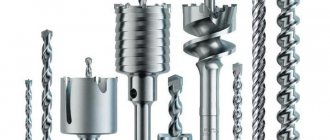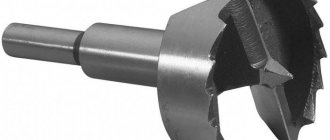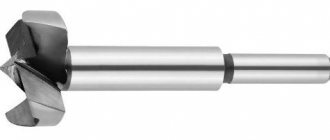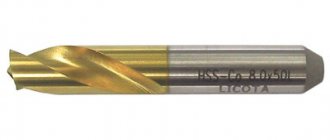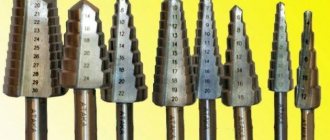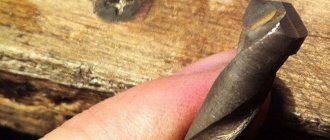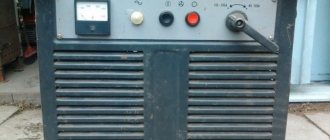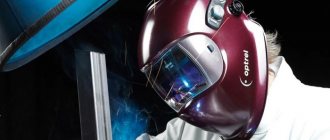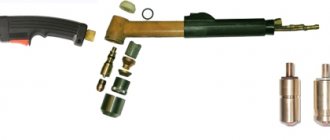From the author: Hello friends! To carry out repair and construction work, it is often necessary to drill into concrete and brick walls. Drills for metal surfaces are not suitable; they quickly begin to become dull and differ in the cutting part, quality and other features. Therefore, you need to know which drill bits for concrete are best, because there are quite a large number of their manufacturers.
Application
Beginning builders sometimes find themselves in a difficult situation. The drills are new, of a good brand, the drill is in working order, but the resulting hole is not at all as planned, or does not work out at all. Often the reason for failure does not lie in poor work skills or a low-quality tool.
The first thing you should pay attention to is the materials from which the drill is made and the surface where the hole needs to be made. The basic rule is that the cutting tool must be harder than whatever it is going to cut. Proper sharpening of the tip is also important.
If you take a high-quality metal drill and try to make a hole, for example, in concrete, the product will quickly fail. It is not intended for such purposes. Drills with Pobedit tips are suitable for processing the hardest surfaces. Their cutting part is coated with an alloy called “win”, which has increased strength.
On the contrary, such products are often not suitable if processing is required , for example:
- plastic;
- steel;
- tree.
The winner does not cut the material, but rather crumbles it , so the holes are shaggy, ugly and larger than necessary. In the case of plastic, the necessary chip rejection is not ensured. As a result, the hole quickly becomes clogged, which leads to undesirable consequences:
- the load on the drill increases;
- operating time increases and efficiency decreases.
Because of these features, many masters, especially the “old school” ones, advise using pobedit only in suitable cases. However, the classic pobedit drill gradually changed. Now on the shelves there are products with special soldering (inserts), which are used to work with various materials, including “inconvenient” ones. For example, you can find a pobedit metal drill.
What types of concrete drills are there?
Above we looked at what types of tips and shanks there are, now we will look at the types and sizes of drills that manufacturers offer us. The smallest diameter of a drill for concrete is 4 mm, that is, it will not be possible to drill a hole thinner, and the depth of such a hole will be no more than 6 centimeters. Of course, it is possible to find a drill of this diameter and greater length, but due to the physical properties of the metal, such a drill is unlikely to withstand rotation and impacts for long. Even with a slight deviation from the drilling axis, a long thin drill will break.
If you need to drill holes of greater depth, you will have to choose a drill of a larger diameter, since manufacturers produce concrete drills in which the dependence of length on diameter is directly proportional. So, with a diameter of 12 millimeters or more, drills with a length of 1000 mm are produced, which will be enough for through drilling of any wall, unless it is a bunker.
The maximum diameter of drills of this type is 30 mm. It is difficult to work with such a drill; the hammer drill is heavily loaded and requires more cooling time.
If it is necessary to drill a hole of a larger diameter, then core drills are used. Their peculiarity is the presence of a centering drill and a “crown” around it. Thanks to the presence of the cavity, drilling occurs much faster and with less load on the hammer drill.
Core drills also come in pobeditovy and diamond-coated ones; the rules of use and drilling methods are similar to conventional drills:
- Pobeditov set the hammer drill for impact and drilling;
- Diamond - only for drilling.
History will win
The alloy called “Pobedit” was created in the USSR in 1929. Intended primarily for the manufacture of cutting tools. The main goal of the developers was to select the optimal composition and obtain a material of exceptional strength. A solution has been found. The alloy, new at that time, included the following metals:
- tungsten (90%);
- cobalt (10%).
They began to make soldering for drills from pobedit and use it for other purposes. New technology has made it possible to significantly simplify and make more efficient the processing of materials that are particularly durable.
Since its creation, the composition of the alloy has changed many times: a different ratio of tungsten and cobalt was used, additives were added, etc. Now you can find solutions that:
- have different proportions of components;
- cheaper;
- easier to manufacture;
- more durable;
- suitable for working with less hard materials (steel, aluminum, etc.).
Despite the fact that the compositions of such modern alloys differ markedly from the classical ones and from each other, they are still called Pobedit.
“Win” or not “win”
The Pobedit alloy, invented in the first quarter of the last century, consisted of 96% tungsten carbide and 4% cobalt. In the modern classification according to GOST, such a material corresponds to an alloy under the index VK4. The number in the marking of hard alloys indicates the percentage of cobalt. Nowadays, for carbide drill tips, most manufacturers use VK8 alloy (92% tungsten carbide and 8% cobalt). Special additives are added to the alloy to improve cutting performance and extend the service life of products with carbide tips. However, due to the ingrained habit of the people, the drill for working on concrete, brick, stone, glass or tile remained “Pobedit”.
Design features and operation
Unlike some other drills, Pobedit drills do not require sharpening. They initially have the required tip structure (angles) for proper operation.
The cutting part is represented by two “shoulders” of approximately the same width. Where they intersect is the future center of the hole . If their widths are different:
- the diameter of the hole will determine the larger “shoulder”;
- as the craftsmen put it, the drill will “break” the hole: it will turn out larger than necessary;
- physical activity will increase;
- the intensity of the drill will increase;
- drills break more often.
If the tip becomes dull , it can be sharpened. In this case, you need to keep in mind:
- The angle depends on the hardness of the material to be processed. The stronger the surface, the smaller it is.
- Pobedit does not tolerate too much heat. At high values, the tip may crack or even separate from the drill. Therefore, you need to prevent overheating and cool it more often when sharpening. For example, plain water will do.
- If overheating does occur, do not cool it suddenly. Otherwise, cracks will appear. It is best to allow it to cool naturally, that is, on its own.
If the diameter of the product is small, then it will most likely fail earlier. This rule applies even to experienced craftsmen. Therefore, it is better to stock up on a certain supply of drills to save time and nerves. Some masters argue that sometimes “courage” is also important. The work spirit can also be lost after going to the store. The extra ones will still come in handy later.
Main types
There are many types of drills made from Pobedite. They differ in manufacturer, quality, and price. Depending on the shape of the shank, there are:
- hexagonal: regular or recessed for quick installation;
- cylindrical - chambered for a standard drill;
- SDS - can be fixed in most rotary hammers;
- triangular - they are held especially securely and do not rotate.
The diameters are also different. Values start from 3 mm. Pobedit drills are:
- for working with stone, brick, concrete;
- for gas and foam concrete;
- for ceramics, glass, tiles.
Drill bits for the hardest surfaces
Pobedit drills for stone, brick, and concrete are the most popular. Most of them can be used in shock mode. The sharpening angle is usually 130°. Some companies make the tip shape more complex:
- the angle is greater;
- the tip is centering.
If the hammer drill mode is selected, the tool crushes the surface like a chisel. The removed material is removed thanks to special grooves on the steel body of the drill. The usual number of these devices is from 2 to 4. They also have another purpose. The grooves prevent the drill from getting stuck while rotating.
Some manufacturers, on the contrary, prohibit the use of their products in shock mode. It depends on the characteristics of the alloy and the sharpening angle.
Typically, winning products in this category are considered disposable. At least that's what sellers do. However, craftsmen often sharpen them themselves and use them again. This requires an electric sharpener and a little practice.
Sometimes you need to get a large hole. If the diameter is from 65 to 120 mm, special crowns are used. Their design also includes a similar drill.
Drills for porous concrete
Today, building products made from porous concrete are very popular:
- foam concrete;
- aerated concrete;
- silicate
If a small hole is required, a regular metal drill bit may work. Its disadvantage is that it is short-lived. It is better to choose a standard victorious one. In this case, you don’t have to worry about the plaster.
If a hole of 30−120 mm is required , Pobedit drills with special brazing are used for the following materials:
- externally similar to feather drills for wood;
- shank - up to 450 mm, piercing through a standard block;
- the strength of the alloy is lower than for stone;
- for waste disposal there is a spiral of 1-1.5 turns;
- Any drill or hammer drill will do, the only condition is to use the non-impact mode.
Can be used for surfaces with external or internal finishing. The main thing is that there is plaster - without a reinforcing mesh of metal.
Drill bits for tiles, ceramics, glass
On sale you can find products designed for other types of material:
- glass;
- tiles;
- ceramics.
They are distinguished by the following features:
- the pobedit tip in such cases is made in the shape of a cone;
- the shank is round, sometimes in the form of a hexagon;
- used in shockless mode;
- diameter: 3−12 mm.
Sometimes the design of this type of drill is strengthened:
- pobedite plates - two;
- cutting edges - four;
This results in smoother edges and increased accuracy. It is usually recommended to use a rotation speed of about 400-800 rpm during operation. Products with a diameter of 10 mm are most often in demand.
There are other nuances when working:
- If you need a hole of 20-94 mm, “ballerinas” are used - circular drills. With their help you can change the diameter of the hole. Consist of two pobedit plates. Sometimes a mesh is included to protect against splinters.
- If small holes are required, then drills of this type are quite suitable for concrete. Moreover, there may be plaster on it.
Many manufacturers recommend using water cooling during operation. This will help:
- extend service life;
- increase efficiency.
Advantages and disadvantages
The distinctive properties of the pobedit tool made it indispensable when carrying out a variety of construction and repair work.
Among the obvious advantages of Pobedit drills, it is important to note the following properties:
- These drills can successfully process even hard materials such as brick, concrete, ceramic tiles, marble and granite. Regular tool steel drills will not be able to handle this.
- Thanks to its thoughtful design, a Pobedit drill will not be much more expensive than a regular drill without an additional tip.
- The tool does not require preliminary sharpening and is immediately ready for use.
- A large number of types of Pobedit drills are produced. Therefore, finding a tool with a shank for the required type of chuck is not difficult.
- Pobedit takes shock loads well, so it works successfully on a hammer drill in shock mode.
- Some high-quality drills are capable of processing reinforced concrete by drilling through reinforcement.
- Pobedit is not afraid of abrasive inclusions, which are found everywhere in concrete.
The disadvantages of this tool include the following:
- Since the drill crumbles the material being processed, it is almost impossible to get high-quality holes in metal or wood. To process them, it is better to use a different type of tool.
- The cost of a Pobedit drill will be slightly higher than usual, but this is justified by their uniqueness, durability and performance.
- When working with particularly durable materials, Pobedit concrete drills require periodic cooling.
- When using a cheap tool, pobedite deposits often burst or become unsoldered from the drill.
Selecting a Victory Drill
The stores now have a large selection of drills made from Pobedit. You can always choose something suitable for a specific case, given working conditions and material. They are sold individually or in sets.
Product prices may vary greatly. It depends:
- from the manufacturer, brand recognition;
- from the country of manufacture;
- from the seller.
As a rule, popular European brands are more expensive . They are usually worth it, as they are distinguished by:
- good quality, including sharpening;
- mandatory guarantee;
- The tips are difficult to distinguish against the general background, since the soldering is very neat.
There are mid-level products. The cheapest products include products from unknown companies. Their common disadvantages include:
- strength - low;
- do not always correspond to the stated characteristics.
Drills from Bosch
Bosch products are well known to everyone. The company also produces drills with pobedit tips. Their diameter ranges from 3 to 25 mm.
Blue Granite series products are designed for stone processing. They are distinguished by:
- reliability;
- quality;
- They drill concrete better than ordinary pobedit ones;
- U-shaped groove for good waste removal;
- used with impact drills.
You can also highlight:
- Silver Percussion - also for stone and concrete of special strength.
- Impact - for processing natural and artificial stone.
- Karat - designed for drilling any surface except concrete and artificial stone. The cutting part is sharpened in a special way and sharper, so the edges of holes in various materials are smooth.
- Black Quartz - for roof tiles and tiles. Can withstand heavy loads.
DeWalt drills
Among the manufacturers, DeWalt stands out . The products of the Extreme SDS-Plus series are especially famous. Its features include:
- diameters - from 4 to 16 mm;
- shank - round or hexagonal;
- the cutting part is serrated, even takes concrete with reinforcement;
- the groove is in the shape of a jug, it removes debris well;
- the tip is attached to the drill using a special technology; special solder with copper is used;
- due to the design, such products can better withstand overheating;
- the holes are very smooth.
When choosing pobedit drills from any manufacturer, it is better to give preference to those that are designed for a specific material. If the tool is used infrequently, you can get by with “wide-spectrum” products. In any case, it is important to feel the characteristics of each type in work and practice.
